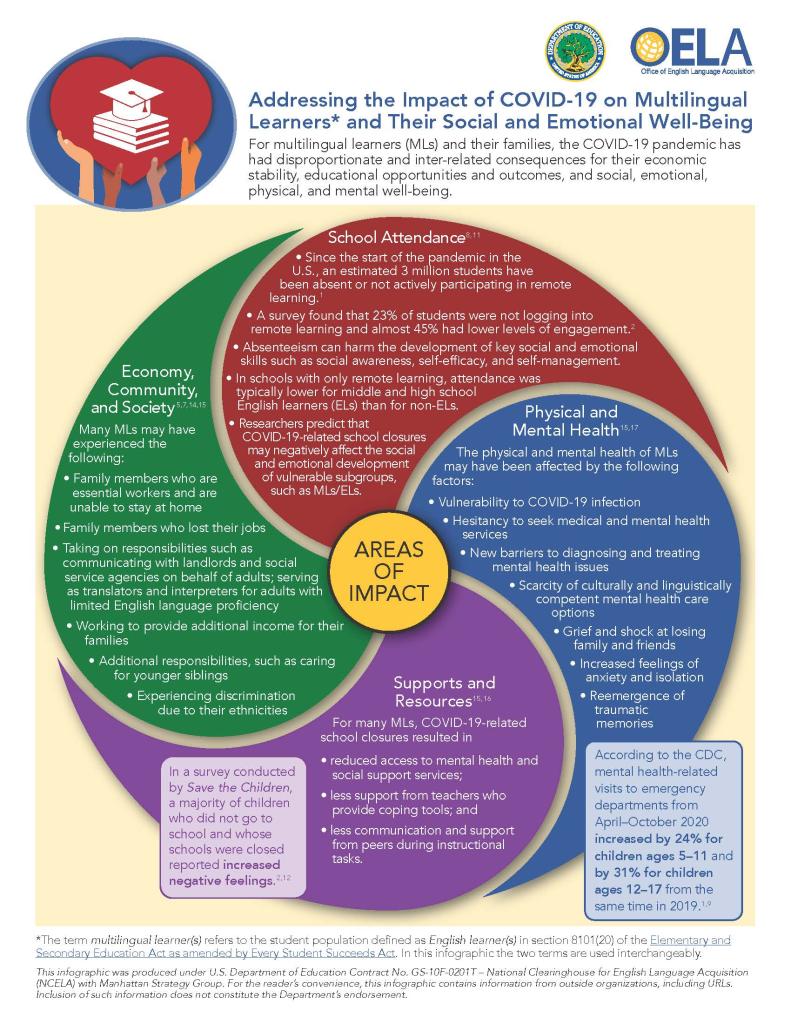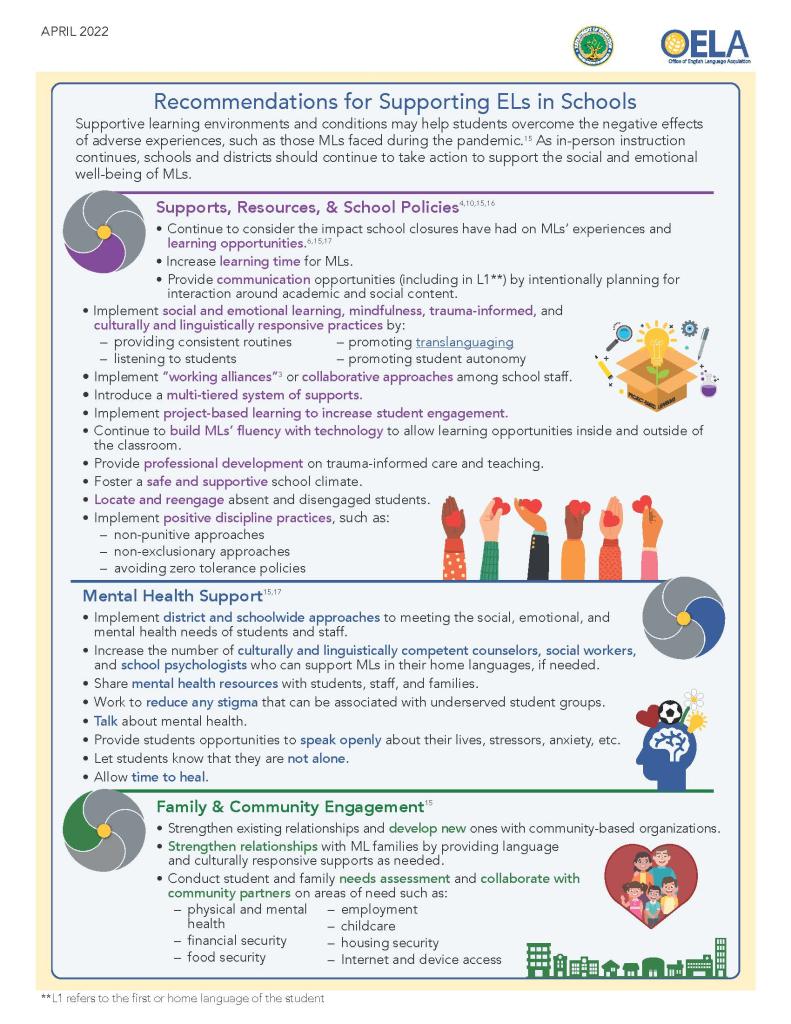By Jen Himmel and Tatyana Vdovina
With a new school year in full swing, it’s an excellent time to reflect on the challenges still facing K-12 education due to the COVID-19 pandemic. Specifically, it’s a time to reimagine and reenvision education for multilingual learners (MLs), who have been particularly affected by the last few years’ disruptions. Schools struggled to adequately meet the academic needs of MLs even before the pandemic, but the newfound attention to this student population and historic current levels of federal funding present a unique chance to improve schools’ support for MLs and their families.
A recently published fact sheet from the National Clearinghouse for English Acquisition (NCELA) indicates that in School Year (SY) 2019–2020, 10.4% of K-12 students were learning English as an additional language. While these students bring rich cultural, linguistic, and content knowledge to the classroom, they require specialized instructional support to keep up with their peers. Research indicates that MLs did not receive this support when many schools transitioned to primarily remote instruction. We can now see the effects on these students’ economic stability; educational opportunities and outcomes; and social, emotional, physical, and mental wellbeing. This recent NCELA infographic details these gaps.
Infographic: Addressing the Impact of COVID-19 on Multilingual Learners and Their Social and Emotional Well-Being


The pandemic exposed persistent inequities in ML education, but it also provided opportunities to overcome these barriers. For all its obvious challenges, COVID-19 generated numerous research opportunities, which continue to generate evidence-based resources that educators can use to support multilingual learners. During school year (SY) 2022–2023, these stakeholders can improve ML education by focusing on the following challenges:
Learning, enrollment, and attendance loss: Some estimates suggest that many students lost a quarter of an academic year during the pandemic, and on average, MLs lost 20% more learning than non-MLs. Research shows that some practices to accelerate learning may be more effective than others, including small group tutoring and providing MLs with enhanced opportunities to read, write, and fully participate in conversations in science, math, history, and language arts throughout the day. Accordingly, instructional practices that proved effective prior to the pandemic are only more necessary now, including evidence-based teaching practices like robust vocabulary instruction, peer-to-peer interaction, and home language support and development.
COVID-19 has also disrupted the path to graduation for some older MLs who have either dropped out of high school or may be at risk of doing so. Educators should be aware of the warning signs of dropping out, including course performance, repeated courses, incomplete student schedules, and chronic absenteeism. A recent OELA webinar and podcast featured an expert panel discussing the supports that schools and districts can provide to MLs and their families to mitigate the impact of the pandemic on their educational opportunities and achievement.
Teacher training and support: Recent survey data indicate that teacher shortages are now at historic levels, including in bilingual education. One promising teacher preparation model includes Grow Your Own programs, which can successfully identify and prepare future teachers that have specialized instructional and linguistic skills necessary to work with MLs and their families. States and districts can also utilize the creative approaches to instruction that they employed during the pandemic. For example, many districts and schools explored language instruction approaches that are less disruptive to MLs’ instructional day, such as co-teaching models rather than services where MLs are removed from the general education classroom for some of the instructional day.
Social and emotional wellbeing: Not all schools have the to provide culturally and linguistically relevant social and emotional supports to students and their families. To ensure MLs and their families’ social and emotional needs are met, schools can hire school psychologists, social workers, and other related staff who can speak MLs’ home languages. When hiring multilingual staff is not an option, schools can work with community organizations to identify cultural and linguistic liaisons to work with to assess the social and emotional wellbeing of MLs and their families.
Family engagement: Schools are a vital connector to communities across the country and are often the first interaction that newcomers have with U.S. institutions. Prior to the pandemic, many schools struggled to meaningfully connect with and support ML families, and these connections weakened in many cases during COVID-19. But high-tech approaches to family engagement that began during the pandemic, including text messaging and platforms like WhatsApp, can promote two-way communication with families. Other schools are increasing the frequency of in-person meetings to reconnect with newcomer families. The U.S. Department of Education has published a back-to-school checklist to help families learn more about their district’s return-to-school plans so that families are better equipped to assess how the district is promoting a safe and engaging school environment for their learner.
We are now in the midst of the third school year of the COVID-19 era, and though the challenges may be different than in 2020, they are still formidable. If there’s a silver lining, it’s that educators now have greater knowledge about the virus’s educational effects, and new funding and tools to address them. We can see which populations have been challenged and target the fastest-widening gaps. Multilingual learners may have lost ground in certain ways, but there’s arguably never been a better time to focus on their unique needs.


